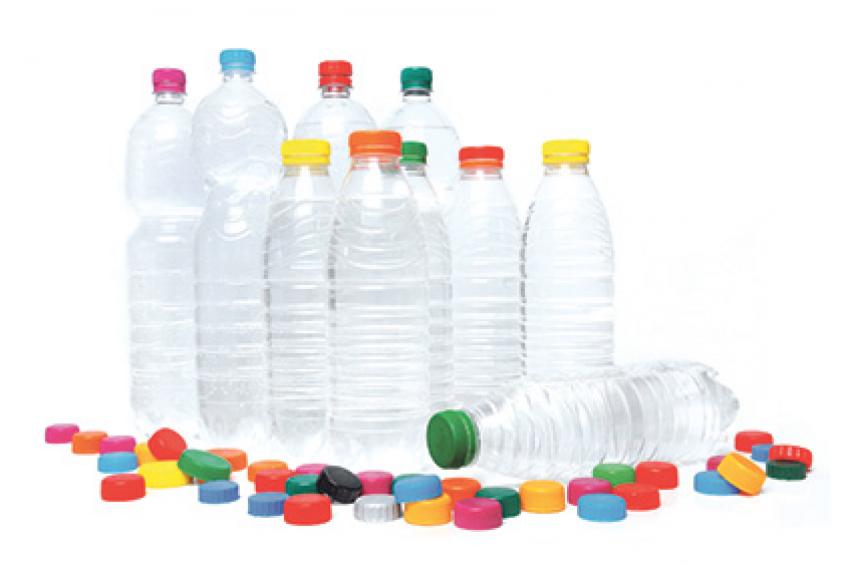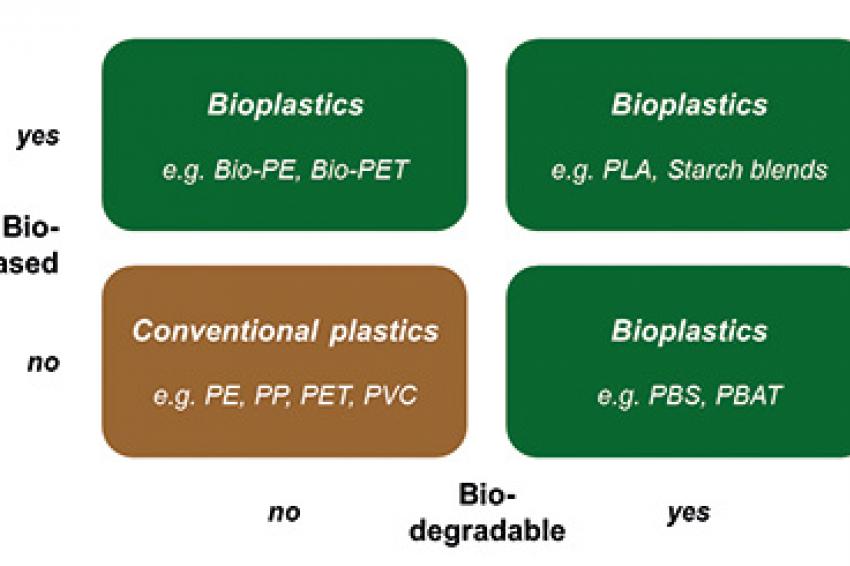Bioplastics Commercialization in Asia
Heading East Can Mean Heading Green
Going Green, Going East - Developing more sustainable materials and meeting demand patterns in Asian growth markets are two of today's major challenges for European chemical companies. While Asia will play a critical role in any large-scale commercialization scenario of bioplastics, its regional differences are striking when considering parameters such as feedstock availability, industry infrastructure, customer industries and government policies.
Bioplastics receive an increasing amount of attention by both industry and consumers as one of the main drivers toward a bio-economy. The term bioplastics, however, encompasses a range of polymers that can either be bio-based (at least partially), biodegradable or both (fig. 1). As of today, these materials account for approximately 1.5% of global plastics demand, but it is estimated that they could substitute up to 85% of conventional polymers.
Biodegradable plastics such as starch blends or polylactic acid (PLA) have dominated early bioplastics market development with applications in food packaging, catering products, shopping bags or agriculture. More recently the concept of replacing conventional oil-based plastics such as PE, PP or PET with their bio-based counterparts has gained commercial importance. These "drop-in" solutions focus on durable applications in rigid packaging, health care, consumer goods or automotive sectors and will dominate future capacity additions in the bioplastics industry.
A recent study by Nova Institute forecasts global biopolymer capacities to grow from 3,500 kt in 2011 to approximately 12,000 kt in 2020. New production capacity in Asia alone will be larger than combined additions in the rest of the world. To better understand the drivers behind these projections, it is essential to analyze feedstock availability, industry infrastructure, customer industries and government policies in some of the region's key countries - notably Japan, Thailand and China (fig. 2).
Japan: R&D Cluster
With its high dependency on oil-based naphtha imports, Japan strives to strategically diversify its raw material supply. Its traditionally strong chemical companies, innovative customer industries and environmentally conscious consumers provide fertile ground for development and launch of bio-based material alternatives. Automotive powerhouse Toyota is on the global forefront in committing to the use of bioplastics in applications such as vent louvers or radiator end tanks.
Chemical industry players Mitsubishi Chemical, Mitsui or Teijin are all engaged in bio-based material research projects. Japan, however, lacks the natural resources and agricultural space to become a bioplastics production center on its own. Large-scale investments of Japanese companies are therefore taking place in feedstock-rich regions of the world. Mitsui has entered a joint venture for bio-PE production with Dow Chemical in Brazil, and Mitsubishi Chemical is constructing a bio-PBS plant with its local partner PTT in Thailand.
Thailand: Production Hub
Other investments in Thailand - e.g., the 75 kt PLA monomer plant of Purac - give evidence of the country's ambitions in becoming the major production hub for bioplastics in Asia. Two competitive advantages stand out: First, Thailand's big agricultural base as a major global cassava and sugar exporter, and second, supportive government policies addressing strategies, standards and incentives in the National Roadmap for the Development of the Bioplastics Industry.
Furthermore, Thailand boasts a strong upstream chemical value chain including numerous starch, sugar and glucose plants as well as the largest plastics processing industry in Southeast Asia. In terms of sheer size, however, all eyes are on China.
China: Key Market (To Be ... )
China is the largest plastics processer in the world. Since 2010 its annual plastics consumption is larger than that of all European countries combined. It must therefore play a crucial role in any large-scale commercialization scenario of bioplastics. Current bioplastic capacities in China are yet remarkably small at approximately 300 kt and focus almost entirely on biodegradable materials such as starch, PBS and PLA. Local market demand is at present almost negligible.
But interpreting the ongoing Chinese paradigm shift "from rapid development to more inclusive growth," there are at least three major end-user effects driving the market potential for bioplastics in the country:
- Increasing purchasing power and rising environmental consumer awareness
- More sophisticated, value-added products being manufactured in China
- Proliferation and globalization of Chinese brands.
While the first two points have made Western companies adjust their product portfolios to local demands, the last one is too frequently ignored. Chinese companies such as Huawei, Haier, Lenovo and Geely are becoming truly global brands and increasingly receptive to more innovative technologies. They require dedicated marketing efforts and application support from Western chemical suppliers.
In the light of these developments, SusTech Consult conducted a primary survey among more than 100 plastics processing companies in China to analyze their views on current and future use of bioplastics.
Survey Results
Companies participating in the survey were 75% Chinese entities and 25% Sino-foreign joint ventures from different value chain positions: original equipment manufacturers (OEMs), branded converters and custom molders. Primary focus of the survey was on durable applications.
A first finding: Compared with other aspects of "green plastics" such as hazard-free materials, energy efficiency in production or recycling solutions, bio-based polymers are currently still of low importance to plastics processors in China. Notable exceptions were identified in IT, rigid packaging and consumer goods segments.
Only 5% of companies interviewed had used bioplastics in the past. And if so, mainly for testing or special series purposes. Major reasons for not using bioplastics are high material prices and poor performance properties. Furthermore, a striking 18% of respondents stated that the concept of bioplastics was entirely unknown to them. So besides improving cost/performance issues, a key lever for developing the Chinese bioplastics market is investment in customer education.
Looking ahead, the key drivers for bioplastics in China are seen as twofold (figure 3): A stricter legal framework would push the market in the short- to mid-term, whereas increasing consumer demand and related green strategies of end-users will pull the market in mid- to long-term.
Strategic Implications
Bioplastics in Asia - and especially in China - is no low-hanging fruit. While Thailand is on the way to become one of two or three global supply hubs for bioplastics, the Asian demand perspective is significantly more difficult to assess. Educating Asian customers along the value chain on bioplastics is a strategic priority. Within this, evolving global brand owners from China constitute a widely unexplored target group for European bioplastic producers.
Contact
Sustech Consult
Rumfordstr. 9
80469 München
Germany
+49 89/20339865
+49 89/20339132








